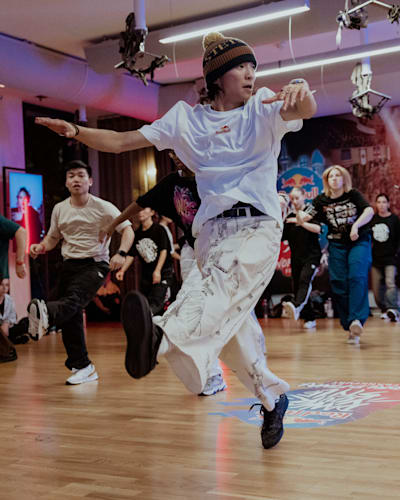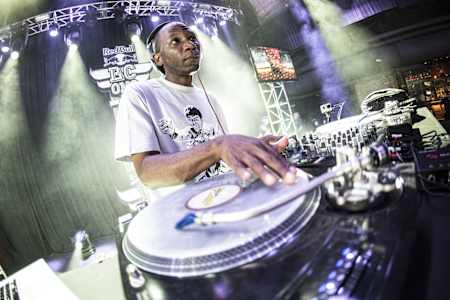Breaking

Dance
Get yourself familiar with the past, present and future of hip-hop
Dive into the dynamic world of hip-hop, from its cultural roots to becoming a music and dance phenomenon enjoyed by people around the world.
Hip-hop is a term that echoes through the corridors of music, dance and culture, yet its meaning seems to vary depending on where you stand in its vast landscape. To some, it means a revolutionary cultural movement that gave a voice to the voiceless or a groundbreaking music genre that transcends beats and rhymes, while to others it's a dynamic dance form that speaks through movement.
In this exploration, we'll delve into the multifaceted world of hip-hop explaining where these different interpretations of the word come from and show you how to find out more if you want to dig deeper.
01
A cultural movement about expression and identity
Hip-hop culture, born in the vibrant streets of New York City during the late 1970s, emerged as a beacon of self-expression and empowerment for the youth, particularly in marginalized communities. What started in the Bronx as a response to socio-economic challenges and a lack of recreational outlets rapidly blossomed into a global movement.
Hip-hop began in the 1970s in the Bronx, rooted in Black and Caribbean street culture. It blended rap, DJing, breakdancing, and graffiti, becoming a global force for creativity and self-expression.
It was in the spirited block parties of this borough that hip-hop began to weave its narrative, with DJs like Kool Herc and Grandmaster Flash setting the rhythmic foundation. These gatherings weren't just parties, they were a platform for the youth to express themselves in a society where they felt voiceless.
Central to hip-hop culture are its four original elements: DJing, MCing (or rapping), graffiti art, and breaking (which is also known as breakdancing, b-boying and b-girling). DJing laid the musical groundwork, with DJs experimenting with breakbeats and turntables to create a continuous flow of music.
MCing, or rapping, emerged as the vocal expression, where rhythmic and rhyming speech was used to tell stories and relay messages. On the visual front, graffiti art painted the cityscapes with vibrant murals and tags, becoming a form of street art that gave identity to urban environments.
Breaking, the physical embodiment of hip-hop, combined elements of dance, athleticism and artistry, turning sidewalks and dance floors into stages for breathtaking performances.
Hip-hop culture has transformed into an influential aspect of global society. It goes beyond being a type of music or dance, it represents a way of life that encompasses a unique philosophy, fashion, language and perspective on the world.
The different elements of hip-hop have become tools for storytelling, social commentary and building communities reflecting the realities and aspirations of an entire generation. As it has spread across continents, hip-hop has adapted to contexts resonating with diverse groups and giving birth to new forms of expression and sub-genres. A few examples of these sub-genres are gangsta rap, trap, boom bap, alternative hip-hop, conscious hip-hop, drill. Its impact goes beyond its contributions as it continues to shape social, political and cultural conversations worldwide.
Check out the video below as the Red Bull BC One All Stars explore New York with Alien Ness and Grandmaster Caz.

42 min
Exploring NYC with Alien Ness and Grandmaster Caz
Alien Ness and Grandmaster Caz take us on a trip to the roots of breaking in the Bronx of New York City.
While each element of hip-hop culture is deeply interconnected, business interests and evolving creative landscapes have led some, particularly music and dance, to carve out their own distinct identities and trajectories outside the larger cultural movement.
Find out more about the impact of hip-hop as a cultural movement.
02
The rise of hip-hop music
The musical genre of hip-hop, which originally served as the pulsating soundtrack to a cultural revolution, has since ascended to dominate the global stage. The interplay of beats, breaks and spoken word gave birth to a new kind of sound.
As artists like Run-DMC, Public Enemy, and N.W.A emerged they propelled hip-hop from the streets to the mainstream, using their music to narrate the realities of urban life, social injustice and resistance. The genre's raw authenticity and bold storytelling resonated deeply, allowing it to swiftly capture the hearts and ears of a broader audience.
As hip-hop music progressed it went beyond its audience and geographical boundaries reaching various communities and cultures worldwide. The 1990s were an important era for this genre with iconic figures such as Tupac Shakur, The Notorious B.I.G. and Lauryn Hill shaping its path and values.
This period not only saw hip-hop dominating the music charts but also leaving its mark on fashion, language and lifestyle. Recognizing its increasing influence record labels began investing in it propelling hip-hop to unprecedented levels of commercial success.
By the 2000s hip hop had firmly established itself in mainstream music culture with artists like Jay Z, Eminem and OutKast achieving global recognition. Its impact was undeniable as it influenced music trends while also giving rise to new sub-genres like grime in the UK.
Today, hip-hop stands as a colossal force in the music industry, continually evolving and influencing. It has given rise to new stars and styles, from the introspective rhymes of Kendrick Lamar to the genre-blending sounds of Kanye West. The digital age has further amplified its reach, with hip-hop tracks frequently topping streaming platforms and influencing social media trends.
Its global impact is seen in the way it has been embraced and localised in countries around the world, creating a universal yet diverse dialogue through music. As a testament to its enduring appeal and adaptability, hip-hop continues to shape and reflect societal narratives, proving that what started as a movement in the Bronx has indeed become a universal language.
Rap speaks to the masses and became a behemoth in the music industry
© Gabriele Seghizzi / Red Bull Content Pool
Due to this broad reception in the mainstream, music, for many, is the first thing that comes to mind when hearing the term hip-hop. But there is another giant competitor in the room.
03
Hip-hop dance takes over streets, studios and stages worldwide
Hip-hop dance, often referred to as hip-hop freestyle or newstyle, is a dynamic and expressive art form that emerged from the same cultural movement. Its roots can be traced back to the late 1960s and early 1970s, originating in the urban communities of New York City.
Unlike breaking which focuses on acrobatic moves and floor work, hip-hop dance is characterized by its free-form nature and rhythmic movements that align closely with the beats of hip-hop music. This dance style started as a form of street dance, primarily a spontaneous and improvisational expression, allowing dancers to showcase their styles and personalities. The basic moves of the style are a mix of social dances and moves that were created to accompany rap tracks on MTV, which traditionally featured dancers.
Originally hip-hop was freestyle but choreography has hit the mainstream
© Emily Gardner / Red Bull Content Pool
As hip-hop music began to gain momentum, so too did the dance style associated with it. The 1980s and 1990s saw the popularization of hip-hop dance in mainstream media, largely attributed to its incorporation in music videos, movies and television shows - Soul Train being the one you can't afford to not know.
Dance crews and solo artists began to gain recognition, bringing the dance from the streets to stages and screens worldwide. The infusion of various elements from other dance styles, like jazz and contemporary, led to the diversification of hip-hop dance, making it more accessible and appealing to a broader audience. This era also marked the birth of dance battles and competitions, which became crucial platforms for dancers to exhibit their skills and gain recognition.
Today hip-hop dancing continues to play an ever-changing role within the world of hip-hop culture. It has firmly established itself in both the scene and the mainstream dance industry. Thanks to the rise of media and digital platforms hip-hop dance has gained a global following inspiring a new wave of dancers.
Workshops, dance schools and online tutorials have made it more accessible, allowing enthusiasts from all corners of the globe to engage with this artistic form. With its evolution and adaptability hip-hop dance remains a vibrant and significant expression of contemporary culture showcasing the creativity and energy of young people worldwide.
Find out everything you need to know about the world of street dance below.

23 min
Get To Know Street Dance
Learn about the origins of street dance and discover the styles that have evolved from its humble beginnings.
As we've explored the world of hip-hop from its origins as a groundbreaking cultural movement to its global influence in music, dance and beyond it becomes apparent that hip-hop is more than just a genre or style. It's a living breathing entity that continues to grow, inspire and empower. It transcends boundaries and resonates with people from all walks of life.
Whether it's the lyrics of a rap song, the fluid movements of a street dancer or the bold strokes of graffiti art, hip-hop remains an ever-evolving force. A universal language of creativity and self-expression. In its changing form, hip-hop not only stays relevant but also remains essential. A testament to its lasting impact and legacy.














